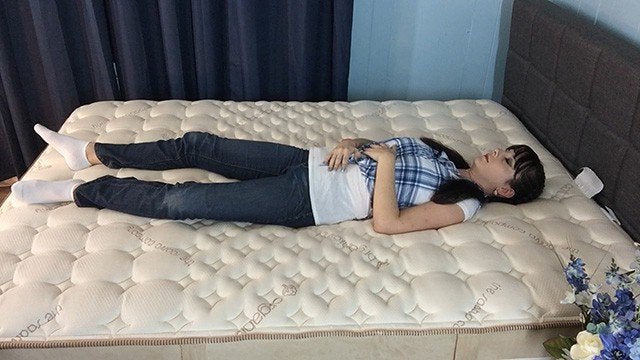For a long time, researchers have studied the effects that different sleeping positions have on our body, be they positive or negative. While some sleeping positions are better than others, there is no universal rule saying that every is better off choosing this one particular sleeping posture, so it’s always important to experiment with what works best for you. If you are able to get a decent night’s rest and not wake up feeling sore the next morning, it doesn’t really matter what sleeping position you choose. But what about sleeping upright? Is this position recommended? And how does one go about sleeping in this position, anyway?

Is It Healthy to Sleep Sitting Upright?
According to the Sleep Foundation, sleeping while sitting upright is neither here nor there. The important thing while you’re sleeping (regardless of the position chosen) is to be comfortable and get enough sleep. If sleeping upright will help you accomplish both those things, then it’s definitely something worth trying.
There are people with certain health conditions that might find it more soothing to adopt this sleeping position, especially if they have chronic obstructive pulmonary disease or morbid obesity. According to Dr. Jenny Iyo (specialized in physical therapy), some people find it more comfortable to sleep in a recliner, as this position prevents them from rolling over to either side and could result in pain, particularly in patients that have postoperative shoulder pain.

Dr. Iyo also suggested that sleeping upright should be considered only as a temporary solution, until the person is able to find comfort in sleeping while lying on the bed. It’s important to make the transition from sleeping upright to fully lying down only after consulting with a physical therapist or a physician.
For certain cultural groups, sleeping upright is a very common practice. For example, there is a Buddhist retreat in Scotland where monks sleep upright for up to four years. This shouldn’t be taken as an example, as the nature of our sleep cycle makes it difficult to adopt this particular sleeping position.
As you might already know, a person’s sleep cycle consists of four different sleep stages. The last stage in the cycle, REM sleep, causes a loss in our muscle tones, leading to our arms and legs feeling paralyzed. When this occurs, you can’t act out the dreams that are characteristic of your REM sleep stage. When you experience this body paralysis, sleeping upright becomes less comfortable.

Sleeping in a standing up position is even more difficult than upright sleep because the REM sleep stage causes you to lose your muscle tone. There are certain situations where people have to sleep in this position, such as soldiers working on night time sentry duty. It has also been observed that certain animals sleep in this position as well, but their bodies are capable of doing so. For example, horses have ligaments and tendons that lock their legs in place when they fall asleep, much like flamingos.
A Word on Deep Vein Thrombosis
It is also important to note that sleeping upright might put you at risk of deep vein thrombosis, a condition that’s characterized by a blood clot formed in the being of your lower leg or thigh. This usually occurs as a consequence of long periods of uninterrupted sitting. If that blood clot travels to the lungs, it could result in potentially fatal pulmonary embolism. Smokers and expecting mothers are at a higher risk of developing deep vein thrombosis.

If you have deep vein thrombosis, you are likely to experience pain/swelling where the clot is located, redness on your skin, tenderness/warmth in the location of the affected vein.

But what happens when you’re a frequent long-distance airline traveler and you end up sleeping upright during your flights? Experts suggest periodically standing up and moving your legs, but also drink plenty of water to stay hydrated. Reclining your seat (if possible) is also recommended if you want to avoid ending up with deep vein thrombosis.
Sleeping Positions & Health Conditions
When you’re suffering from a medical condition, you might be left wondering what sleep position is best for you to try to sleep as comfortably as possible and get a full night of interrupted sleep. So, what are the pros and cons of the most common sleeping positions?
#1: Back sleeping
When you’re lying flat on your back, that’s when supine sleep occurs. The legs normally rest in a neutral position, with your arms lying flat on the sides of your body or bent with your hands placed on your body.

This is one of the best sleeping positions for people that don’t experience any breathing problems. When you’re sleeping on your back, that’s when your body gets full support from the mattress and the pillow. If you invest in a supportive pillow and place it behind the knees, you can also benefit from musculoskeletal pain or pressure reduction. If you raise your feet adobe the heart, it can relieve swelling in the ankles and feet. It also helps reduce the impact of congestive heart failure.
Naturally, there are some drawbacks to consider if you prefer sleeping on your back. However, if you have any health condition that’s causing breathing problems (such as sleep apnea), this position is the worst one to try (unless you’re using a CPAP machine to help you breathe). When sleep apnea is associated with back sleeping, you are more likely to experience insomnia, dry mouth, snoring, mood disorders, bruxism, nocturia, fatigue, diabetes, heart attack risk, palpitations, and even ADHD.
#2: Left side
While often referred to as “sleeping on the side”, it’s important to note that there are some different things going on inside your body when you sleep on your left, as opposed to sleeping on your right side. When you choose to sleep on the left side, you’re dodging the impact of supine sleep and it will most likely prevent you from snoring and might help you breathe better.

It’s also an ideal position for those of you experiencing pain in a right-sided joint. During pregnancy, mothers can experience some comfort while sleeping on the right side, especially if they place a pillow between their knees or under their stomach. This will help relieve back pain and pressure on the bladder.
Sleeping on the left side could pose a series of disadvantages for some people. For instance, the organs in the thorax might shift and the lungs may apply pressure on the heart. Due to this pressure, the heart may respond by triggering the kidneys, causing you to urinate more frequently during the night. Other drawbacks to sleeping on the left side may include hip, shoulder, or lower back pain.
#3: Right side
Much like sleeping on the left side, sleeping on your right can also combat some of the negative effects of supine sleep. It’s also the best position to adopt if you’re experiencing any joint pain on the left side.

When you sleep on your right side, the heart’s mediastinum shifts towards your right lung. This reduces the lung’s volume, which might further affect you if you have certain pulmonary conditions. It could potentially cause a drop in your blood oxygen levels and lead to straining of your cardiovascular system if you have health conditions related to it. When pressure is applied to the nerves of your right arm and leg, some of the possible consequences include neuropathy or injuries.
#4: Stomach
While this is the least common sleeping position, it’s also the least recommended one. It is very common for people who spend most of the night sleeping on their stomach to wake up with neck stiffness. This is because your head is forced to the side since sleeping face down would leave you breathless in less than a minute. When you sleep on your stomach, the upper part of your body is forced to rest in an unnatural position, but it can also restrict breath because the body weight reduces your lung volume.

Even if you should avoid sleeping on your stomach, there are few advantages to this position. It helps prevent the thorax organ shifting, and sleeping with your arms close to the body conserves heat.
#5: Upright

A lot of people are skeptical about the potential benefits of sleepers choosing the sitting up position. When you sleep upright, you are less likely to experience a collapse of your airway, which diminishes the risk of snoring and could improve sleep apnea symptoms. Depending on the exact upright sleeping position, this could also help relieve pain.One of the major drawbacks of sleeping sitting up is the fact that you can’t change the position while you’re asleep.
How to Sleep Sitting Up
If you are invested in the idea of sleeping sitting up, here is a list of this that will show you how to make it happen:

- The first thing to keep in mind is that you want to make the best use out of gravity as possible. Sleeping with a sloped surface behind you is going to help you a lot. For instance, you can try to sleep against a particle board that’s placed on the bedroom wall at a 70° angle. If you don’t want to get your back scratched against its surface, you can place a towel on top of it.
- If you’ve slept on a bed for as long as you can remember, you are going to find the lack of padding extremely uncomfortable. You can improvise some padding for that particle board by simply putting a pillow against it. If you plan on sitting on the floor, make sure that you also place a pillow on the floor to sit on.
- One of the most important things to consider when you want to master the art of sleeping upright is to have proper lower back support. Having proper lower back support means allowing your spine to maintain its natural curve but it also helps with leaning the head back on the board behind you. You can either use a lower back pillow or a rolled up towel for back support.
- Neck support is also essential when sleeping upright. While some claim that it’s not necessary to have it, it will definitely make the transition easier. Whatever you choose for neck support has to be thicker at the back of the neck and thinner behind the head. There are multiple pillow types that you can use for this. You want to avoid anything that pushes your head forward too much because this will make you wake up with neck pain.
Conclusion
There isn’t really enough scientific evidence to suggest that sleeping sitting up is healthy or unhealthy, so it’s mostly a matter of what medical conditions you have that could make this posture easier for you to get some decent shut eye. Experts state that while sleeping upright is necessarily a bad thing, it isn’t a long-term solution, but it might work until your body is ready to transition to the usual sleeping position.
Photo credit: Charlene Bayerle/Shutterstock; metodej/Shutterstock; Dragana Gordic/Shutterstock;
GBALLGIGGSPHOTO/Shutterstock; YAKOBCHUK VIACHESLAV/Shutterstock;
Nektarstock/Shutterstock; SibRapid/Shutterstock; Paymaster/Shutterstock